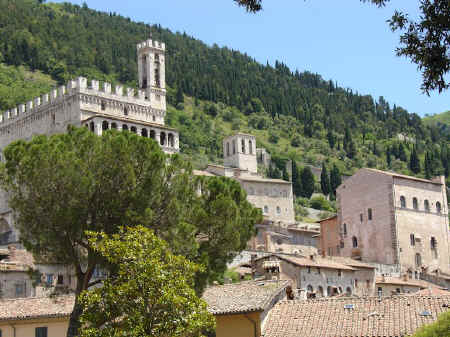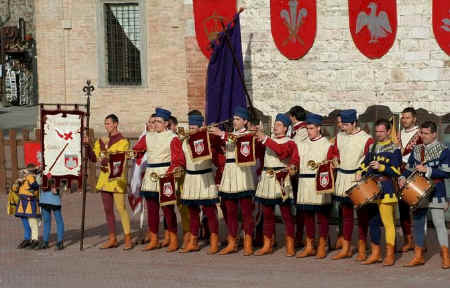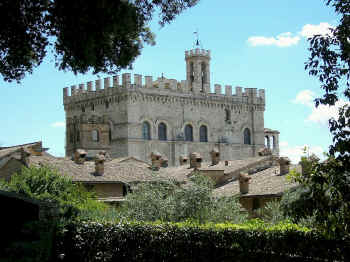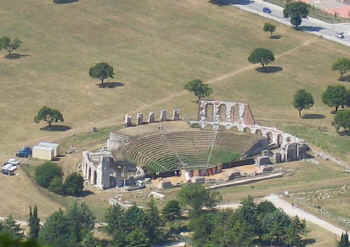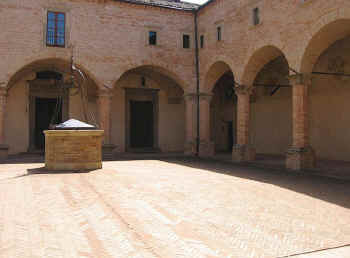|
Gubbio is in Umbria, Italy, 40 km NE of Perugia and about 65 km S of Urbino in the neighbouring region of Le Marche, Italy. The town is beautifully located on the lower slopes of Mt. Ingino. Gubbio is an extremely ancient town mentioned in the famous Eugubine Tablets and was in the past the capital of Umbria. Gubbio's compact town centre has a good selection of mediaeval, Gothic and Renaissance structures built of gray limestone and has great views over the beautiful countryside. Just outside the town is a Roman amphitheatre. “Gubbio Italy” The Eugubine Tablets are sheets of bronze inscribed in ancient Umbrian using a modified Etruscan alphabet and the latin alphabet. They date from the second or first century BC and were discovered in 1444. They are displayed in the civic museum of Gubbio and are the longest texts so far found written in the extinct Umbrian language. More history of Gubbio.
Palio della Balestra at GubbioIt has been a tradition since the Middle Ages that every year in May the crossbowmen from Sansepolcro come to Gubbio to compete in honour of Saint Ubaldo, and on the second Sunday of September the crossbowmen from Gubbio return their visit and compete in honour of Saint Egidio, patron of Sansepolcro. The crossbowmen from Sansepolcro and participants in the procession wear Renaissance costumes reproducing those of the frescoes by Piero della Francesca. The target of the crossbow shooting is called "corniolo" and is located at a distance of 36 m from the crossbow. A special jack is employed to bend the crossbows. During the shooting the weapons are laid on a special bench due to their heavy weight. (For other festivals in Umbria, click here.) Palio della Balestra (Crossbow competition) in Gubbio Italy Main sights of Gubbio• The Duomo (Cathedral) of Gubbio dates from the late 12 C. The most striking feature is the rose-window in the facade flanked by the symbols of the Evangelists: the eagle for St. John, the lion for St. Mark, the angel for St. Matthew and the ox for St. Luke. The interior is in the form of a latin cross with a single nave. Its high altar is a Roman sarcophagus. The most precious art piece is the wooden Christ over the altar, of Umbrian school.
• Palazzo dei Consoli of Gubbio is a huge 14 C Gothic building made of limestone. Inside is an art gallery, archaeological museum and the civic museum which houses the Eugubine tablets, seven bronze plaques written in the ancient Umbrian language. The palazzo, on Piazza della Signoria, dominates the town. Palazzo dei Consoli, Gubbio, Italy
• Church of San Francesco dates from the second half of the 13
C and is located in the lower town on the big green Piazza Quaranta
Martiri, where buses arrive. It's a Gothic church with an impressive rose
window and unusually has a nave with two aisles. Inside on the left
there is a fresco dating from the 1400s, The Life of the Virgin, and frescoes from the 1200s
may be seen in the main apse. In the cloister there are remains of Roman mosaics. Roman Theatre at Gubbio
• The Palazzo Ducale of Gubbio, built from 1470 by Luciano Laurana or Francesco di Giorgio Martini for Federico da
Montefeltro. The famous inner court, reminiscent of the Palazzo Ducale of
Urbino, is open to visitors. Abbey of Sant' Ubaldo • Porta Romana, at the east end of town, is a museum with a collection related to medieval gates, including old keys and drawbridges, and some ceramics. Near
this gate there are two 13 C churches. |
